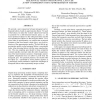Free Online Productivity Tools
i2Speak
i2Symbol
i2OCR
iTex2Img
iWeb2Print
iWeb2Shot
i2Type
iPdf2Split
iPdf2Merge
i2Bopomofo
i2Arabic
i2Style
i2Image
i2PDF
iLatex2Rtf
Sci2ools
ICIP
2005
IEEE
2005
IEEE
Hexagonal versus orthogonal lattices: a new comparison using approximation theory
We provide a new comparison between hexagonal and orthogonal lattices, based on approximation theory. For each of the lattices, we select the "natural" spline basis function as generator for a shift-invariant function space; i.e., the tensor-product B-splines for the orthogonal lattice and the non-separable hex-splines for the hexagonal lattice. For a given order of approximation, we compare the asymptotic constants of the error kernels, which give a very good indication of the approximation quality. We find that the approximation quality on the hexagonal lattice is consistently better, when choosing lattices with the same sampling density. The area sampling gain related to these asymptotic constants quickly converges when the order of approximation of the basis functions increases. Surprisingly, nearestneighbor interpolation does not allow to profit from the hexagonal grid. For practical purposes, the second-order hex-spline (i.e., constituted by linear patches) appears as ...
| Added | 23 Oct 2009 |
| Updated | 14 Nov 2009 |
| Type | Conference |
| Year | 2005 |
| Where | ICIP |
| Authors | Laurent Condat, Dimitri Van De Ville, Thierry Blu |
Comments (0)

